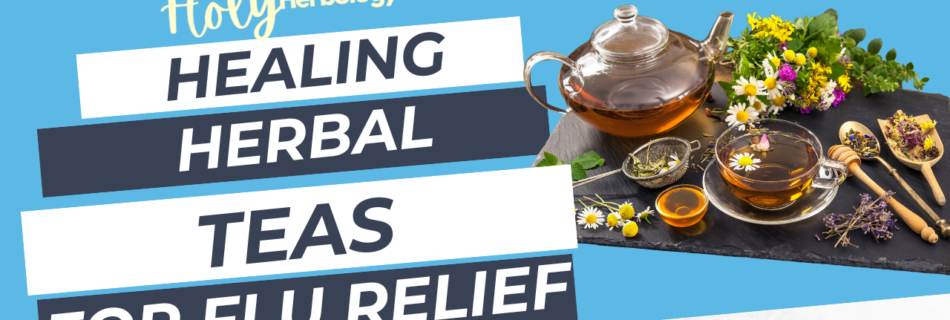Healing Herbal Teas for Flu Relief: Natural Remedies for Sore Throat, Congestion, and Cough
If the flu strikes your household this year, don’t worry because Holy Herbology has you covered. By turning to herbal teas for flu relief, you’ll find a gentle yet powerful way to get through the cold and flu season. Unlike over-the-counter medications that often mask symptoms, herbal teas for flu relief work naturally with your body, helping to soothe, heal, and restore balance. This post will guide you through the healing properties of four key herbal teas for flu relief: ginger, thyme, peppermint, and elderberry. Learn how these teas can help you feel better naturally, with detailed tips on how to make the most of their incredible benefits. 1. Ginger Tea: The Warming Healer Historical Context Ginger has been used as a herbal medicine for thousands of years. Coming originally from Southeast Asia, it has been used both in Ayurvedic and traditional Chinese medicine for everything from digestive ailments to nausea and upper respiratory problems. Ginger was valued similarly in ancient Greece and Rome, where not only did it function as an expensive spice, but it also was claimed to cure many common complaints. The Color and Its Meaning Ginger tea has this pale golden color, symbolizing clarity, warmth, and healing. According to color psychology, gold portrays wisdom, generosity, and illumination, acting just like ginger does at times of an illness: bringing comfort and clarity. How It Works Various bioactive compounds of ginger, such as gingerol and shogaol, exhibit strong anti-inflammatory, anti-oxidative, and anti-viral properties. These help to reduce the swelling of the throat and respiratory tract, collaborate in nausea reduction, and help in strengthening the immune system. Besides these, ginger is a natural expectorant, helping to facilitate the expulsion of mucus to alleviate congestion. DIY Recipe and Preparation Method Advanced Tips: Usage: Drink 2-3 cups daily to relieve flu symptoms. It’s especially effective in the morning to boost energy and soothe the stomach. Safety Note Ginger is generally safe but can cause mild side effects like heartburn or stomach upset in some people if over consumed or an irritation is developed. Pregnant women should consult with a healthcare provider before using large quantities of ginger. 2. Thyme Tea: The Respiratory Reliever Historical Context Thyme has been used medicinally since ancient times. The Greeks used it for antiseptic purposes and as a fumigant in temples, while the Romans used thyme in their baths and to flavor cheese and liqueurs. During the Middle Ages, thyme was put under pillows to keep nightmares away and also was used for respiratory problems and against infections. The Color and Its Meaning Pure thyme tea has the color of light yellow-green, which makes it remind one of freshness, vivacity, and purification. Green is a color that represents renewal and health, while yellow is a color that represents energy and happiness, reflecting the refreshing and restorative nature of thyme. How It Works This effect is indebted to a powerful antimicrobial and antifungal agent present in thyme, called thymol. Thymol is an expectorant that liquefies mucus in the lungs, which helps in a productive cough. Thyme also possesses anti-inflammatory properties that soothe the throat and reduce the urge to cough. DIY Recipe and Preparation Method Advanced Tips: Usage: Drink 2-3 cups daily to help reduce coughing and ease respiratory discomfort. Safety Note While thyme is generally safe, people with allergies to mint or oregano should use it cautiously. Large amounts of thyme oil should be avoided, as they can be toxic. 3. Peppermint Tea: The Cool Comforter Historical Context Peppermint has a long record of being used as a medicinal herb since ancient times. The Egyptians, Greeks, and Romans valued peppermint for its specific benefits to the digestive system. In Europe, it had its high time in the 18th century as a curative against indigestion, headaches, and colds. The Color and Its Meaning The tea is light green in color, but often carries a cool, fresh aroma. Green pertains to renewal and healing, while the coolness brought by peppermint offers a refreshing sensation to soothe the senses. How It Works Peppermint contains menthol, which is a natural decongestant or muscle relaxant. It helps to open up the airways, and it makes breathing much easier with a cooling sensation to soothe a sore throat, thereby reducing the urge to cough. Peppermint houses antibacterial effects too that are of help during an infection. DIY Recipe and Preparation Method Advanced Tips: Usage: Drink 2-3 cups daily to relieve symptoms of congestion and sore throat. Safety Note Peppermint tea is generally safe for most people, but it can cause heartburn in individuals with acid reflux due to its relaxing effect on the esophageal sphincter. Pregnant women should use it sparingly as it can stimulate uterine contractions in high amounts. 4. Elderberry Tea: The Immune Booster Historical Context It has been used in folk medicine for centuries in virtually every European country, in North America, and other parts of the world. In medieval Europe, the elderberry plant was called a “medicine chest” because of its myriad uses. Elderberry was also employed by Native American Indians to treat infections and injuries and to produce a natural dye for fabric. The Color and Its Meaning Elderberry tea has a rich, dark purple color, almost black, due to its high anthocyanin content. The deep purple signifies power and protection, aligning with elderberry’s role in supporting and strengthening the immune system. How It Works Anthocyanins, flavonoids, and vitamin C in elderberries have antiviral and antioxidant properties. This may help improve immune system response, fight viruses, and reduce symptom severity and duration of the flu. Among these, the tea form is particularly highly useful for thinning mucus and congestion, soothing a sore throat, and providing overall immune system support. DIY Recipe and Preparation Method Advanced Tips: Usage: Drink 2-3 cups daily during flu season for immune support, or more frequently at the onset of symptoms. Safety Note Elderberries should not be eaten raw, as they contain compounds that can cause nausea and vomiting. Cooking elderberries makes …

